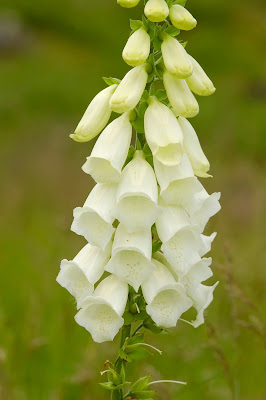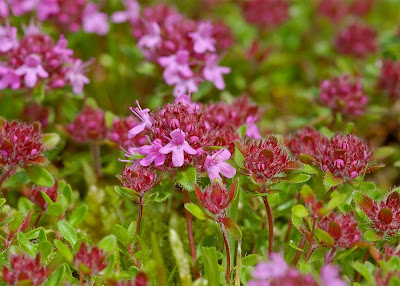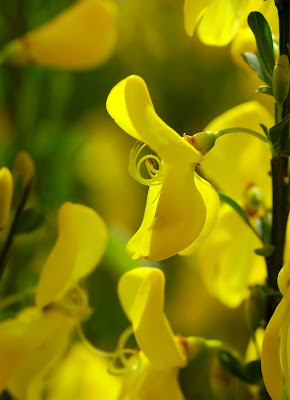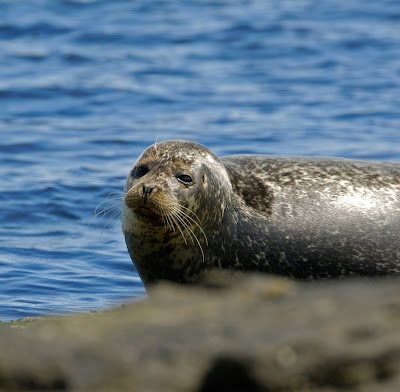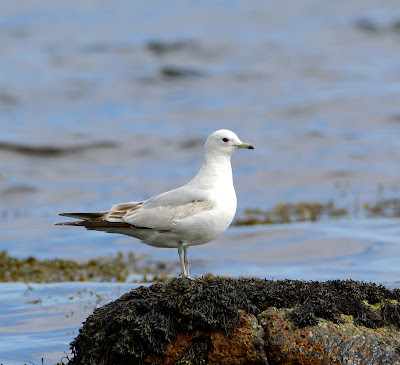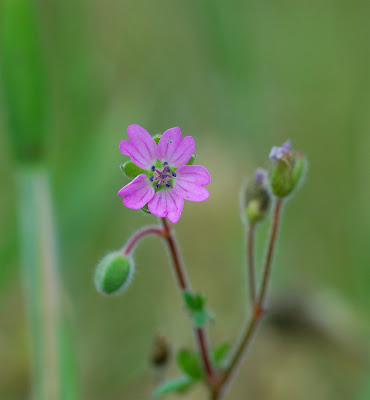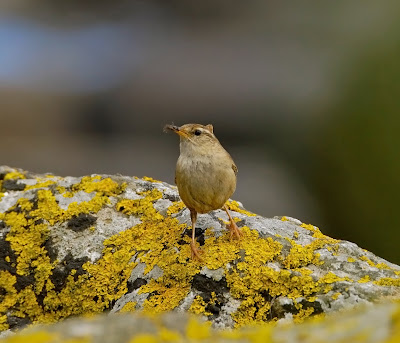Arran has a very varied geology, which has given rise to a rich diversity of shore types. The shores at Kildonan are a mixture of white sandy bays, shingle beaches and basalt dykes (with plenty of rockpools).
Raised Beach near Kildonan at Port a'Ghille Ghlais
The luxuriantly vegetated cliffs of the hinterland are a classic example of a post-glacial raised shore, formed when land rose after the melting of glacial ice sheets, whose weight previously kept this land depressed.
Tertiary basalt dykes at Kildonan
Basalt dykes and sills form tall, lichen-crusted rock-walls which chop the shore into segments and extend into the sea. These intrusions were formed in the Tertiary when molten magma intruded into pre-existing rock layers, in this case Triassic mudstone (sedimentary rock formed from clay or mud).
When many dykes arise from a single volcanic event they form what is known as a 'dyke swarm', of which Kildonan has one of the best examples in the world.
More in-depth info on Kildonan's geology can be found at these sites:
Coastal Zone Assessment Survey of Port a' Ghille Ghlais to Kildonan (Map 5) produced by SCAPE & Historic Scotland.
Site Report by the Joint Nature Conservation Committee (JNCC)
Isle of Pladda (left) and the Ailsa Craig (right) from Kildonan
Isle of Pladda with Ailsa Craig behind
Lighthouse on Pladda
The Isle of Pladda is a flat-topped volcanic sill and was formed when magma flowed sideways between pre-existing rock layers. Once cooled, this magma was harder than surrounding rocks and resisted erosion, forming a cliff above softer rocks. It has had a lighthouse since 1790, though the current building dates from around 1830.
Ailsa Craig
The Ailsa Craig (also known as Paddy's Milestone) is a sharply conical volcanic plug composed mostly of microgranite (a very hard, fine-grained granite) which contains the minerals riebeckite and aenigmatite. It has the 3rd largest Gannet colony in the UK and many of these birds can be seen fishing around the coasts of Arran.
Kildonan is a great place to see Common Seals (
Phoca vitulina): a large colony is present all year and the seals seem surprisingly tolerant of human presence. As we approached the seals we could hear their snorts, grunts and wails echoing off the green cliffs curving round the bay.
Dog-owners should keep their pets on a leash along this stretch of shore to avoid disturbing the seals, as they haul out very close to the coastal path.
Common Seal (Phoca vitulina)
Common Seal (Phoca vitulina)
Common Seal (Phoca vitulina)
Common Seal (Phoca vitulina)
Common Seal (Phoca vitulina)
Common Seals (
Phoca vitulina) can be distinguished from Grey Seals (
Halichoerus grypus) by the following features:
- V-shaped nostrils (the Grey Seal has almost parallel nostrils).
- Rounded head with short snub-nosed muzzle. Pronounced dip between forehead and muzzle (the Grey Seal has a long 'Roman nosed' muzzle and a flat forehead).
- Eyes positioned on the front of the face, closer to the nose than the back of the head (Grey Seals have their eyes positioned slightly on the sides of the head, halfway between nose and back of head).
- Fur is very finely and uniformly mottled with pale outlines/rings around darker grey spots (Grey Seals have more strikingly marked, blotchier coats often with sharply contrasting patterning).
Common Seals are the smaller of the two species, weighing 45-105 kg (males are only slightly bigger than females). Unlike Grey Seals, Common Seals are born without a woolly white fetal coat (called lanugo) as it is shed in the womb.
The Common Seal's scientific name means 'calf-like seal' (
Phoca = seal: from Latin which is derived from the Greek phoke,
vitulina = calf-like: Latin).
Common Seal (Phoca vitulina)
Seals have highly sensitive whiskers known as vibrissae (those on the muzzle are mystacial vibrissae) which are used in the tactile detection and identification of prey.
Common Seals (Phoca vitulina)
Seals may look sluggish and ungainly on land but in the water they're amazingly graceful and possess an amazing array of adaptations to their marine habitat including the ability to fully collapse their lungs when diving, the ability to drink seawater and the presence of myoglobin in their muscles (which has a 40% higher oxygen-carrying capacity than haemoglobin).
Common Seals (Phoca vitulina)
Some of these Common Seals will be heavily pregnant females and will give birth over the next few weeks (Grey Seals pup at a different time of year: from September til early December).
Common Gull (
Larus canus) first-summer
We found an Oystercatcher's nest on the upper shore, it contained four cream eggs marked with blackish speckles and scribbles - the parent quickly and quietly returned to incubate once we were a few metres away.
A quick list of some of the birds seen today in Kildonan bay: a Curlew, 3+ pairs of Oystercatchers, a Hooded Crow, 2 Gannets, countless Rock Pipits, numerous Common and Herring Gulls, 5 Shelduck, 3 Merganser and a Buzzard.
Common Stork's-bill (Erodium cicutarium)
Common Stork's-bill is a delicate pink-petalled flower related to geraniums, so-named because its long seed pods supposedly resemble storks' bills.
The seeds of this plant each possess a long bristle (known as an awn) which gives them the unusual ability to bury themselves. These awns, although composed of dead cells, are hygroscopically-active: they straighten when wet and coil into corkscrew helices when dry.
Coiling of the awn causes the seed to be fired from the seedpod and the motor action which results from the coiling and uncoiling of the awn causes the seed to move across the ground surface - until it falls into a crevice - and then enables it to drill itself into the soil.
A detailed account of this unusual process can be found
here.
Dove's-foot Crane's-bill (Geranium molle)
Hemlock Water Dropwort (Oenanthe crocata)
Hemlock Water Dropwort (Oenanthe crocata)
Hemlock Water Dropwort (Oenanthe crocata)
Hemlock Water Dropwort has leaves which smell appetisingly of Celery and bear a strong likeness to Lovage, however the whole plant (particularly the tuberous root) is deadly poisonous. It contains oenanthetoxin which affects the central nervous system, causing severe convulsions and in many cases, death.
How to Identify Hemlock Water Dropwort:
- The whole plant is entirely hairless.
- Leaves are 3-4 pinnate, toothed, slightly glossy and parsley-scented.
- Stout stem is grooved.
- Flowers are white and possess both upper and lower bracts.
3-4 pinnate = leaves are composed of leaflets arranged along an axis, each of which is further subdivided into leaflets which are themselves subdivided (and again for 4-pinnate leaves).
Western Marsh Orchid (Dactylorhiza purpurella)
Western Marsh Orchid (Dactylorhiza purpurella)
Rock Arch
Sea Milkwort (Glaux maritima)
Sea Milkwort (Glaux maritima)
Smooth Hawksbeard (Crepis capillaris)
Smooth Hawksbeard (Crepis capillaris)
Rock Pipit (Anthus petrosus)
Wren (Troglodytes troglodytes)
Wren (Troglodytes troglodytes)
Wren (Troglodytes troglodytes)
Wren (Troglodytes troglodytes)
Wren (Troglodytes troglodytes)
I followed this little Wren as it hopped over boulders and deftly snatched insects out of the air.
Male Wrens are polygamous: each male builds a series of nests on his territory and tries to entice females to visit them: female Wrens prefer males who have more nests.
A female who is impressed with his collection of 'cock's nests' will mate with him and line a nest with feathers before laying her eggs. The male will then set about attracting another female to another one of his nests (the females incubate the eggs & do most of the young-rearing).
Lichens - Lecanora rupicola?
Lichens - Lecanora rupicola?
As they compete for space, these lichens form a beautiful map-like pattern of crackled continents with boldly demarcated borders.
I found them growing on boulders in the supralittoral or 'splash zone' of the upper shore - I think they *might* be
Lecanora rupicola.
Orange-tip (Anthocharis cardamines) female
We walked back along the bay, until we reached Kildonan Hotel: to the side of the carpark there is a huge, rusty propeller leaning against the wall of a white-washed boathouse. House Sparrows nest in gaps under the roof.
House Sparrow (Passer domesticus) male
House Sparrow (Passer domesticus) male
House Sparrow (Passer domesticus) male
House Sparrow (Passer domesticus) male
Brown-lipped Banded Snail (Cepaea nemoralis)
The Brown-lipped Banded Snail (
Cepaea nemoralis) is one of two
Cepaea species found in Britain (the other being
Cepaea hortensis - the White-lipped Banded Snail). Due to the extreme polymorphism of shell patterning and colour found in both species, they can only be identified conclusively by dissection. However, most Brown-lipped Snails have a brown lip to their shells.
Studies on the genetics of shell colour and pattern in
Cepaea nemoralis (
here and
here) have demonstrated that brown shell colour is dominant over both pink and yellow, that pink colouration is dominant over yellow, unbanded is dominant to banded patterns, and that darker banding is dominant over paler banding.
Evolutionmegalab.org has excellent photos of the various
colour morphs.
My specimen is a yellow, hyalozonate (transparent banded) individual (very faint double banding is visible in the full-size photo). Some shell morphs provide better camouflage in certain habitats - yellow snails are more common in grassland and darker snails predominate in woodland. Shell colour also affects the thermal properties of a shell: lighter (yellow) shells reduce heat absorption.
I collected lots of holey stones from the shingle shore between Port a'Ghille Ghlais and Bennan Head:
Pebbles with bivalve (Hiatella arctica?) bore holes
Pebbles with bivalve (Hiatella arctica?) bore holes
Pebbles with bivalve (Hiatella arctica?) bore holes
Pebbles with bivalve (Hiatella arctica?) bore holes
Pebbles with bivalve (Hiatella arctica?) bore holes
Pebbles with bivalve (Hiatella arctica?) bore holes
Pebbles with bivalve (Hiatella arctica?) bore holes
Pebbles with bivalve (Hiatella arctica?) bore holes
These smoothly drilled holes, up to 1.5cm in diameter, are the work of bivalve molluscs: most likely the Wrinkled Rock Borer (
Hiatella arctica), given the location and size of burrow.
Juveniles attach themselves to substrates using byssus threads and gradually carve burrows for themselves using the valves of their shells to mechanically abrade solid rock.




